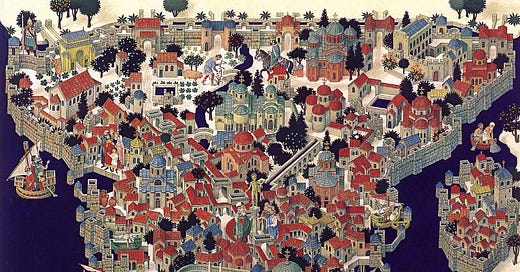By the Width of a Wall: How Christendom Survived, and Turned on Itself
The siege of Constantinople and the road to Iconoclasm
It is difficult, across the long centuries, to feel the urgency of that year, but in 717, Christian civilization itself stood on the brink. In 718 we came within a hair’s breadth of extinction and survived, literally by the width of a wall.
The fragile Christian kingdoms of the European West, still picking themselves up and reforming after the collapse of Roman order, might never have survived. The monasteries of Ireland and Britain, the seeds of the Carolingian Renaissance, the flowering of Christendom in the Middle Ages… all might have been stillborn.
We’re back from our eventful Easter holiday and we return today to pick up our story of Christian civilization under siege. We looked last time at the disaster of the Islamic conquest of Christian Spain, where the Visigoths had converted and created a culturally harmonious Christian society, all lost almost overnight. Had Constantinople fallen, there would have been nothing to stop Islamic armies from pushing deeper into Europe. No unified, organised and prosperous imperial power still stood north of the Alps.
Spain had already fallen. North Africa was lost. Syria, Egypt, and the Holy Land had vanished into the Islamic world almost without a fight. Now only Constantinople stood between Christendom and total collapse to the Islamic onslaught. Now the Umayyad Caliphate turned its attention to the imperial city. The first attempt to capture it began in 674, in a long series of blockades and seasonal attacks over several years.
But Constantinople held out thanks to its impregnable walls, the strategic use of its navy, and the deployment of a terrifying new weapon: Greek fire.
In today’s post for paid subscribers, we’ll look at how, in one of Christian history’s most desperate hours, Byzantium fought and survived. And we’ll also begin to trace how that survival against all odds brought with it a profound internal crisis. For not long after the siege was lifted, a new war began inside the Christian world, not over armies or borders but over the sacred image itself.
The age-long internal war against iconoclasm was about to begin.
At The Sacred Images Project, we explore Christian life, thought, history, and culture through the lens of the first 1200 years of sacred art. This publication is entirely supported by readers — no ads, pop-ups or distractions — just thoughtful work, funded by your subscriptions.
While The Sacred Images Project has grown into my full-time work, we're now building toward an even richer, multi-layered platform, with plans for e-books, mini-courses, videos and eventually podcasts and more. Your support helps make this expansion possible.
If you’d like to follow along, you can subscribe for free and receive a weekly article exploring the treasures of Christian history, culture, and sacred art..
Paid subscribers ($9/month) receive a second, in-depth article each week, plus additional exclusive posts featuring in-person explorations, high-resolution downloadable images, behind-the-scenes content, and more.
If you believe in the importance of preserving and deepening our sacred patrimony, I hope you’ll consider becoming a subscriber today.
From the shop: I’m happy to offer this drawing of the Crucified Christ, “Christus Patiens” that I did in the style of the 14th century Umbrian panel crucifixes. It’s printed on the same museum quality 100% cotton, acid-free paper I drew it on.
You can browse the shop here:
If you’d prefer to set up a monthly contribution in an amount of your choice, you can also do that at the studio blog, or make a one-off donation to help keep this work going. If you subscribe through my personal page, I’ll add you as a complimentary subscriber here. And thank you.
I hope you’ll join us below the fold.






